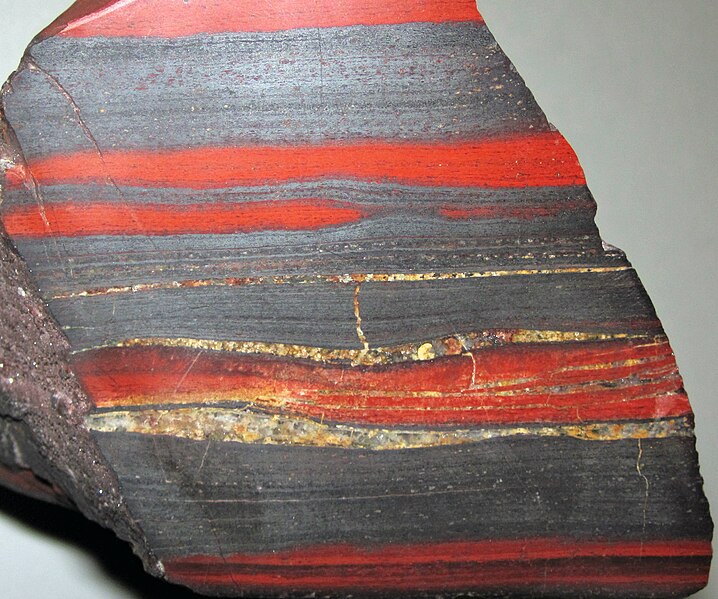File:Jaspilite (Ironwood Iron-Formation, Paleoproterozoic, ~1.874-1.878 Ga; Wakefield, Gogebic Iron Range, Upper Peninsula of Michigan, USA) 1 (27264665499).jpg

Original file (2,293 × 1,914 pixels, file size: 3.12 MB, MIME type: image/jpeg)
Captions
Captions
Summary
[edit]| DescriptionJaspilite (Ironwood Iron-Formation, Paleoproterozoic, ~1.874-1.878 Ga; Wakefield, Gogebic Iron Range, Upper Peninsula of Michigan, USA) 1 (27264665499).jpg |
Jaspilite from the Precambrian of Michigan, USA. (cut & polished surface) Banded iron formations, or BIFs, are unusual, dense sedimentary rocks consisting of alternating layers of iron-rich oxides and iron-rich silicates. Most BIFs are Proterozoic in age (although some are Late Archean), and do not form today - they're “extinct”! Many specific varieties of iron formation are known, and some are given special rock names. For example, jaspilite is an attractive reddish & silvery gray banded rock consisting of hematite, red chert (“jasper”), and specular hematite or magnetite. Because of their age, most BIFs have been around long enough to have been subjected to one or more orogenic (mountain-building) events. As such, most BIFs are folded and/or metamorphosed to varying degrees. BIFs are known from around the world, but some of the most famous & extensive BIF deposits are found in the vicinity of North America’s Lake Superior Basin. Many BIFs have economic concentrations of iron and are mined. BIFs are the most important variety of iron ore on Earth. The BIF shown above is from the Ironwood Iron-Formation of northern Michigan. BIFs are relatively widespread in Michigan’s Upper Peninsula (UP). The Ironwood Iron-Formation outcrops in the western UP’s Gogebic Iron Range. Its layers have been steeply tilted by the Penokean Orogeny (~1.85 billion years) and by mid-continent rifting (~1.10 billion years). The rock shown above is a classic example of jaspilite. It consists of interbedded magnetite-rich layers (= dark gray) (Fe3O4) and bright red hematitic metachert layers (“jasper”). Minor quartz layers, with a little pyrite, are also present. Stratigraphy: Ironwood Iron-Formation, upper Paleoproterozoic, ~1.874-1.878 Ga Locality: iron mine at or near Wakefield, western Gogebic County, eastern Gogebic Iron Range, far-western Upper Peninsula of Michigan, USA |
| Date | |
| Source | Jaspilite (Ironwood Iron-Formation, Paleoproterozoic, ~1.874-1.878 Ga; Wakefield, Gogebic Iron Range, Upper Peninsula of Michigan, USA) 1 |
| Author | James St. John |
Licensing
[edit]- You are free:
- to share – to copy, distribute and transmit the work
- to remix – to adapt the work
- Under the following conditions:
- attribution – You must give appropriate credit, provide a link to the license, and indicate if changes were made. You may do so in any reasonable manner, but not in any way that suggests the licensor endorses you or your use.
| This image was originally posted to Flickr by James St. John at https://flickr.com/photos/47445767@N05/27264665499 (archive). It was reviewed on 10 October 2019 by FlickreviewR 2 and was confirmed to be licensed under the terms of the cc-by-2.0. |
10 October 2019
File history
Click on a date/time to view the file as it appeared at that time.
| Date/Time | Thumbnail | Dimensions | User | Comment | |
|---|---|---|---|---|---|
| current | 00:38, 10 October 2019 |  | 2,293 × 1,914 (3.12 MB) | Ser Amantio di Nicolao (talk | contribs) | Transferred from Flickr via #flickr2commons |
You cannot overwrite this file.
File usage on Commons
There are no pages that use this file.
Metadata
This file contains additional information such as Exif metadata which may have been added by the digital camera, scanner, or software program used to create or digitize it. If the file has been modified from its original state, some details such as the timestamp may not fully reflect those of the original file. The timestamp is only as accurate as the clock in the camera, and it may be completely wrong.
| Camera manufacturer | Canon |
|---|---|
| Camera model | Canon PowerShot D10 |
| Exposure time | 1/60 sec (0.016666666666667) |
| F-number | f/9 |
| ISO speed rating | 80 |
| Date and time of data generation | 16:02, 13 December 2017 |
| Lens focal length | 8.295 mm |
| Image title | |
| Width | 4,000 px |
| Height | 3,000 px |
| Bits per component |
|
| Pixel composition | RGB |
| Orientation | Normal |
| Number of components | 3 |
| Horizontal resolution | 180 dpi |
| Vertical resolution | 180 dpi |
| Software used | Adobe Photoshop Elements 13.0 (Macintosh) |
| File change date and time | 18:14, 13 December 2017 |
| Y and C positioning | Co-sited |
| Exif version | 2.21 |
| Date and time of digitizing | 16:02, 13 December 2017 |
| Meaning of each component |
|
| Image compression mode | 3 |
| APEX shutter speed | 5.90625 |
| APEX aperture | 6.34375 |
| APEX exposure bias | −1 |
| Maximum land aperture | 3.34375 APEX (f/3.19) |
| Metering mode | Pattern |
| Flash | Flash fired, compulsory flash firing, red-eye reduction mode |
| Supported Flashpix version | 1 |
| Color space | sRGB |
| Focal plane X resolution | 16,460.905349794 |
| Focal plane Y resolution | 16,483.516483516 |
| Focal plane resolution unit | inches |
| Sensing method | One-chip color area sensor |
| File source | Digital still camera |
| Custom image processing | Normal process |
| Exposure mode | Manual exposure |
| White balance | Auto white balance |
| Digital zoom ratio | 1 |
| Scene capture type | Portrait |
| Lens used | 6.2-18.6 mm |
| Date metadata was last modified | 13:14, 13 December 2017 |
| Unique ID of original document | 2DB839DAE562DCD703111E7F5C93DC0C |